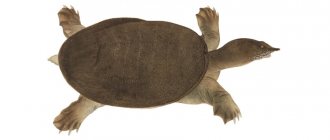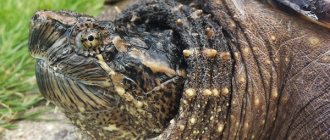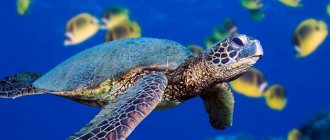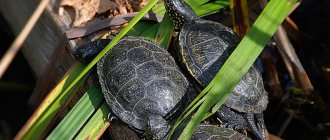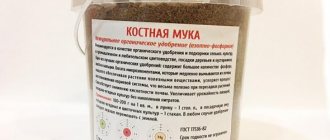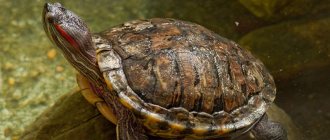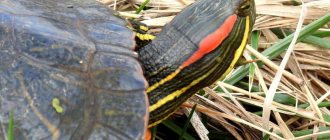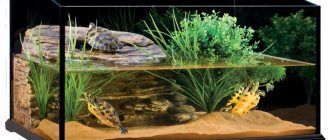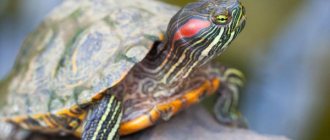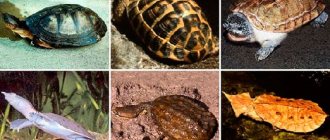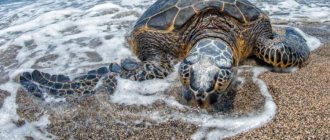Description of the Far Eastern turtle
The carapace is up to 20-40 cm long, covered above and below with soft skin without horny plates.
In juveniles, the carapace is round and covered on top with longitudinal rows of small tubercles, which then merge into ridges that disappear in adults. From above, the turtle is colored greenish-brown with rare yellowish spots. The underside of its body is pinkish-white or yellowish in adults and bright orange in juveniles. The head is covered with light and dark spots, and a dark line runs from the eyes to the neck. After three years, the male grows a long tail with a light longitudinal stripe on top, while the female’s tail remains small. Males are usually smaller than females. The weight of a turtle reaches several kilograms. A long neck with an elongated head ending in a long soft proboscis with nostrils can stretch far and reach the tail. Trionix is able to obtain part of the oxygen from water using so-called pharyngeal breathing. In the turtle's throat there are papillae - bundles of villous outgrowths of the mucous membrane, penetrated by many capillaries, and here oxygen is absorbed directly from the water. Under water, the trionix opens its mouth so that the water washes the villi in the throat. Papillae also serve to secrete urea. The better the water in the reservoir, the less often the diving turtle opens its mouth. These outgrowths allow the turtle to stay under water for up to 15 hours, and the skin, richly supplied with blood vessels, provides skin respiration in water and partly on land, which is extremely rare in reptiles.
The water in the habitats of the Far Eastern turtle is highly saline, and in order to remove urea from the body, it uses a non-standard method. The growths located in the mucous membrane of her pharynx secrete urea. Trionix takes water into his mouth and then spits it out along with the secretions.
Each foot has five toes, the inner three of which end in sharp claws. The fingers are equipped with well-developed swimming membranes. The jaws are very strong, with a sharp cutting edge and, given the extremely aggressive nature of this turtle, pose a certain danger.
Natural enemies
The main enemies of the Far Eastern turtle are birds of prey and mammals. They pose a great danger to the population, as they destroy clutches by digging up turtle nests. In this way, sometimes 100% of the laid eggs disappear. Hatched turtles often do not reach the water, becoming prey to predators. Animals that cause harm to offspring include crows, foxes, raccoons, badgers and wild boars.
An attack on an adult is unlikely to be successful - it is not easy to catch up with the animal both in water and on land. In addition to speed, the turtle has a great bite force and can scare away the enemy.
Habitats of Chinese Trionix
Chinese trionix is widespread in Asia: Eastern China, Vietnam, Korea, Japan, as well as on the Hainan Islands and Taiwan.
Within Russia, it is found in the south of the Far East - the extreme northern border of its range. Inhabits the basins of the Amur rivers (in the north almost from the mouth, upstream to the south to the western part of Primorye, slightly above the mouth of the Sungari), Ussuri and their large tributaries, as well as Lake Khanka. The distribution of the species in Russia is currently confined to two main regions - the Amur region (the basin of Lake Gassi in the Khabarovsk Territory) and the Khanka region (the basin of Lake Khanka in the Primorsky Territory).
Introduced to Southern Japan, the Ryukyu Archipelago, the Ogasawara Islands, Thailand, Malaysia and Singapore, the island of Timor (Indonesia), the Hawaiian Islands and the Mariana Islands (Guam). The discovery in the Chui Valley of Kyrgyzstan should also be considered an introduction. []
Chinese Trionyx inhabits slow-moving rivers and lakes in places with muddy or sandy bottoms, sparse underwater vegetation and gently sloping banks where they can climb out for sunbathing. The turtle not only swims well, dives and buries itself in bottom silt and sand, but also runs quite quickly on land. Typically, turtles are located at the very edge of the water, rarely moving more than 1.5–2 m from it. In extreme heat, in order not to overheat, they can bury themselves in wet sand; some stretch their necks and open their mouths, thereby increasing the area of evaporation. The turtle swims and dives well and can remain under water for a long time.
Main features of the species
This type of turtle is a lover of fresh water and any soft ground, which explains the presence of a soft shell, which is so different from its usual “hard-bodied” counterparts. An additional distinctive feature of this species is their instant reaction to danger. So don’t think that you got your pet the easy way: you had to chase it, especially if it was done in water.
This greenish-gray inhabitant of rivers behaves quite calmly at home, if it has been “raised” by people since birth. He will even be able to eat from human hands. But if you manage to purchase Trionix as an adult, then it is better not to let children get closer than half a meter to these small, toothy “monsters.” With an aggressive nature, a powerful jaw and sharp claws, this turtle can bite and scratch its owner. Therefore, it is safer to have small soft-bodied turtles who will get used to and love their owners from childhood.
This species grows up to 40 centimeters in length, weighing several kilograms (on average up to 4.5 kg).
Food
Young Trionics are fed every day, adults 2-3 times a week. You must choose the amount of food yourself, depending on how much the turtle eats. The approximate serving size for children is 2-3 pieces of 1 cm3, for older adults - 2-3 pieces of 2-3 cm3. The food should be raw and at room temperature. The main food is FISH! It is best to occasionally give live small fish, which can be immediately introduced into the aquarium. Types of food: FISH (lean and different types - hake, cod, gobies, thalassa, etc.), MEAT (specifically internal organs: beef liver, chicken heart, beef heart, but not chicken!), INSECTS and CRUSTACEANS in the form of a rare delicacy (daphnia crustaceans, gammarus, bloodworms, earthworms, legless crickets, woodlice, legless locusts, beetles), OTHER (small freshwater snails, shrimp, tadpoles, frogs). All food should be given with bones, shell (snails) and internal organs so that Trionics can obtain calcium and vitamins from the food.
Home maintenance
Chinese Trionix is sometimes kept at home.
Maintaining the right conditions usually doesn't come cheap, though. An aquaterrarium with a volume of 250 liters or more per turtle is suitable. The ratio of water to land is approximately 5:1. Required use of equipment:
- a good filter: about 2 times more powerful than usually needed for the same volume of water;
- water heater;
- compressor.
Without proper filtration, infections will plague your pet. For the same reason, the appearance of wounds (sharp objects, lamps, etc.) should be prevented. Bacteria and fungi damage the shell.
A compressor is needed to saturate the water with oxygen. The temperature on the heater is 24–29 °C.
The soft shell turtle does not tolerate chlorine. Before changing, the water is allowed to settle.
There are unlikely to be problems with nutrition. The following food is suitable:
- sea and freshwater fish;
- snails;
- bloodworm;
- earthworms;
- fruits;
- vegetables, etc.
The only drawback is the huge appetite. For example, a turtle with a carapace length of 20 cm is capable of eating several fish 10–12 cm long in one sitting. This can put a dent in your wallet.
For normal shell growth, mineral supplementation is necessary. Sometimes ultraviolet lamps are used to absorb minerals and improve metabolism.
Incompatible with any other types. Fish, even much larger ones, crustaceans and other inhabitants will be eaten. They can cause severe injuries to members of their own species. Often it only takes one bite. Better to keep alone. Aquatic plants will also be uprooted and separated into pieces.
The Trionics turtle is shy and rarely comes to land. Adults cannot be tamed. It’s a little easier with young people
Although in any case you should be careful. These turtles are capable of causing serious injuries
Apparently, it is no coincidence that they were depicted on the hilts of samurai swords.
Many pets require special care: scorpions, piranhas, mammalian predators, etc. However, there are always people who are ready to keep them. Chinese Trionix is far from the most difficult option in this regard. If the requirements are met, it can live up to 25 years and bring joy to its owner all this time. In Asian countries it was considered sacred. These reptiles can still be found in ponds at Japanese temples. And in China there is even a proverb in which, in an allegorical form, such a turtle symbolizes a subordinate at work: “Ao gives his voice, and Trionix responds.”
Trionics breeding
They become sexually mature at 6–7 years of age. Turtles mate in March-April and lay eggs in May-August. The behavior of Trionics is especially active from mid-June to mid-July. The turtle digs a bag-shaped hole 15–20 cm deep and 8–10 cm in diameter at the bottom at a distance of 10–35 m from the water, masking it with vegetation. The eggs in the nest are located either in a compact pile or in 2-3 layers separated by sand. Females lay 20–70 eggs 2–3 times per summer. The eggs are covered with a white calcareous shell, have a round shape with a diameter of 18–23 mm and a weight of 5 g. The duration of incubation at a temperature of 28–30°C is 60–89 days, in nature 45–60 days. The length of newborn turtles is about 30 mm.
Interesting facts about the animal
In Asian countries, in the regions of Japan in particular, the endangered Far Eastern tortoise or Chinese trionix is especially valued. It is considered a cult; statues and images are even placed in temples. In ancient times, samurai swords were decorated with pictures of this view - supposedly this gave them courage and strength.
According to one of the beliefs, if you kill too many turtles, then the mysterious spirit Suppon will come to a person, who will leave a mark on fate and take revenge for his fellow creatures.
Still have questions or have something to add? Then write to us about it in the comments, this will make the material more useful, complete and accurate.
Habits of turtles
Far Eastern turtles are very mobile, they run fast, swim, dive and bury themselves well in the sand. Trionics sticks its long nose between the stones in order to search for food or for hunting, as well as to breathe atmospheric air, just by sticking its muzzle out of the water. In search of fish, trionics often visit fishing spots and examine the nets, which naturally arouses the hatred of the fishermen. Trionics hunt at night, when the animals do not sit in ambush, but intensively search their hunting area.
Turtles go to winter in Primorye in mid-September–early October, in Priamurye in late August–mid-September (water temperature 5–8°C). They overwinter, buried in silt, at the bottom of large rivers or in non-freezing holes in large lakes. After wintering in Primorye they appear in April, in the Amur region in the second half of May - the first half of June (water and soil temperature 16°C).
How to contact
Dealing with adult specimens should only be done with special gloves. You need to take them exclusively by the back of the shell. They have an elastic and elongated neck that arches well, and this gives the turtle the resourcefulness to bite.
If Trionix does cause a wound, then you should not delay it in any way. It’s just best to lower the turtle into the aquarium, and it will immediately come off on its own. There were cases when the amphibian did not want to let go of his hand, and he had to open his mouth with an additional iron scoop, sticking it in from the side.
Mature individuals in captivity retain their anger and savagery, but young turtles easily get used to eating out of hand, although they also have a hostile character.
In Japan and China, trionics are caught and eaten; their meat is highly prized. Most often, amphibians are caught with a spear or a fishing rod. Turtle eggs are also edible. There are even some Japanese monasteries that keep Far Eastern creatures in lakes as sacred animals. The Chinese Trionix turtle is also included in the Red Book. The price of a copy in eastern countries is low - about $10.
Drying out is very harmful for the amphibian. Maximum he can stay on land for no more than two hours.
Terrarium for soft-bodied turtles
These very active turtles are best kept in a tall aquarium with a volume of 150 liters or more, or an aquarium with a lid, because Trionics often run away. Trionics need an island with sand only for laying eggs, but turtles like to rest at the surface of the water, rarely crawling out onto land. To avoid softening and distortion of the shell bones, an ultraviolet lamp for reptiles (5-10% UVB) should be installed in the aquarium. Trionics living in an aquaterrarium need an even water temperature (20–26°C). Trionics are very demanding of high ambient temperatures and strong sunlight. The air temperature on the shore is 26–30° C.
Bottom sand or fine gravel, which should be in the aquarium, serves as Trionics’s saving refuge and the best place for aquarium “pastime”. The soil also reduces aggression. The height of the soil layer is 10–15 cm. However, sharp soil can cause fungus (mycosis).
The aquarium is equipped with a good external filter and, if necessary, a water heater. However, Trionics can break filters and heaters, so it is advisable to fence them off with something. In an aquarium with Chinese Trionics, aeration is necessary because Trionics breathe not only atmospheric air, but also that which is dissolved in water. She breathes this air with the help of special villi on the inside of her throat. This allows animals to stay under water for a long time.
Trionics are predators, loners. They cannot be kept with other (non-food) animals. Crowded and/or improper housing often provokes skirmishes, resulting in serious fights that often result in serious injuries, loss of limbs, and sometimes death. You also need to feed the turtle separately from everyone else. Macropod can wean Trionix from hunting other aquarium fish.
Chinese Trionics have a rather vicious temperament, so it is recommended to handle adult specimens with special gloves and only grab them by the back of the shell. They have a very long and flexible neck, which bends easily and gives it great dexterity in terms of biting. If the turtle does bite, then do not pull it under any circumstances; the easiest way is to let it go into the water; it will immediately unhook itself. If she does not want to let go, then you need to unclench the beak with a special iron spatula (not wooden), bringing it from the side.
Macropod can wean Trionix from hunting other aquarium fish.
!!! Drying out is dangerous for Trionics. They can be kept on land for a maximum of a couple of hours. When transporting turtles over long distances, they should be wrapped in a damp towel or buried in damp moss and sprayed regularly.
Aquarium compatibility
Trionics are predators. Carnivorous reptiles should not be kept with animals not intended for food. They will eat all aquarium inhabitants, including macropods: it is believed that these fish are able to wean a soft-bodied turtle from excessive aggression.
It is also not recommended to keep Trionics in groups. Loners by nature, these quarrelsome creatures do not tolerate the proximity of their relatives. If kept crowded in an insufficiently spacious aquaterrarium, violent clashes will periodically occur, ending in serious injuries, mutilations, loss of limbs and even death.
Additional Information
A caught Trionics behaves very aggressively, tries to bite, while its long neck allows it to reach the rear edge of the carapace. The bites of even small turtles are very painful, and large individuals can cause quite serious wounds with the sharp edges of their horny jaws. However, young turtles easily learn to take food from hands, although they have an evil disposition.
In both China and Japan, trionics are caught and eaten, and their meat is highly valued. They are most often caught with a fishing rod or spear. Trionics eggs are also edible. In some Japanese temples, trionics are kept in ponds as sacred animals.
The lifespan of the Far Eastern turtle is approximately 25 years.
Precautionary measures
Trionics are not slow or inhibited. When he suddenly tries to grab himself, he bites sharply with his powerful jaws, leaving painful bites. For calm contact with your pet, follow these precautions:
- Try not to touch the animal. A turtle is not a pet.
- Handle him calmly, do not make sudden movements.
- Handle your pet slowly so that you are within his line of sight.
- Do not handle with bare hands; use gloves or mittens.
- You should accustom your reptile to handling from a young age.
- Show your hands in front of the muzzle so that the pet does not get scared from the suddenness.
View this post on Instagram
Ah the attitude of a softshell ^.^ #chinesesoftshell #softshell #softshellturtle #turtle #turtlesofinstagram #attitude #iliketurtles #savagebeast
A post shared by Gemma Elstob (@gelstob) on Sep 12, 2014 at 3:50am PDT
We weigh the pros and cons
Before you buy a turtle, think about the fact that we are talking about one of the oldest genera of reptiles. More than 220 million! Turtles have lived on Earth for years. They coexist peacefully with humans, but at the same time they never truly became pets.
Even after living side by side with you for a long time, turtles do not rush to see you when they meet you from work, and are happy that you pet them or scratch them behind the ear. You can only appreciate your pet's gratitude by observing its gradual increase in size. Not too much of a reward, would you agree?
If you are still determined and ready to adopt a turtle into your family, you must first resolve the issue of a place for the tortilla to live.
Turtle structure
According to experts, over the past 150 million years, the turtle structure has undergone virtually no change.
The structure of a turtle:
- The shell - this device, consisting of a carapace and plastron, protects the reptile from uninvited guests and predatory enemies.
- Paws are four limbs that, if necessary, can hide in a shell or dig out the ground.
- The tail plays an important role when maneuvering at sea, i.e. With the help of its tail, the turtle sets the direction. The tail, like the rest of the body, is capable of hiding under the shell.
- The turtle's head is of medium size and elongated in shape. Not all turtles are able to stick their heads into their shells, in particular, this applies to those reptiles that are quite large in size.
- Vision – these representatives have ideal vision. Moreover, they have the ability to see and distinguish all kinds of colors.
- Jaw – Turtles do not have teeth. But they have sharp processes, thanks to which they bite through particularly tough food.
In some cases, turtle appendages may have serrations that improve chewing processes and make it easier to hunt prey.
Signs
Unfortunately, there are no external signs of pregnancy in reptiles. A pregnant red-eared turtle looks exactly the same as all other turtles. Most often, pregnancy of freshwater turtles in the wild occurs in the spring and summer. At home, reptiles mate most often in the spring in April-May after a long winter hibernation. During this period, it is recommended to carefully monitor the aquatic turtles so as not to miss the courtship process.
Mating games of red-eared turtles are manifested by the active courtship of the male with the female he likes. The boy swims in front of the girl with his tail first and gently tickles the cheeks of the chosen one with the long claws of his front paws. On land, males can approach females and hit the female’s back with their shell. When several different-sex red-eared turtles are kept at the same time, males can start bloody battles for the right to court the female. In this case, it is recommended to leave a group of several girls and one boy.
Video: mating games
It is almost impossible to find out that a red-eared turtle is pregnant, but you can suspect a successful conception in a female if you can notice mating games and the process of copulation of reptiles. Mating of red-eared turtles occurs in water and lasts from 5 to 15 minutes; during sexual intercourse, the male tightly hugs the female from behind. Sperm can remain active in the female genital tract for up to 2 years. One sexual intercourse is enough for a female to lay eggs 4-5 times.
You can understand that a red-eared turtle is pregnant by the characteristic behavior of the expectant mother. When a reptile carries eggs in itself, it experiences a change in appetite: from its increase to a complete refusal of food closer to the date of birth. Immediately before laying eggs, the aquatic turtle becomes restless, begins to dig the soil, and circles on land in search of a good place for its nest.
The most accurate confirmation of a reptile’s pregnancy is an x-ray examination, with which you can reliably verify the presence of eggs in the female’s genitals.
The pregnancy of a red-eared slider lasts on average 60 days and ends with the laying of eggs. It is recommended that the expectant mother be separated from the male after mating in order to avoid harm to the health of the female and her future cubs. During pregnancy, turtles must be fed a variety of foods, the bulk of the diet should be animal feed rich in calcium.
